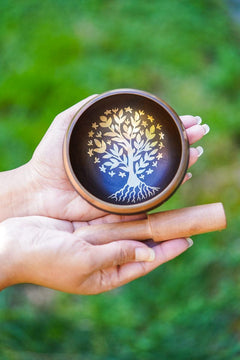Prayer wheels are one of the most fascinating and spiritually rich objects in Tibetan Buddhism. If you’ve never encountered a prayer wheel before, or you’re curious about their purpose and symbolism, this blog will guide you through everything you need to know.
What Is a Prayer Wheel?

A Prayer wheel is a cylindrical wheel traditionally made from metal, wood, or stone, mounted on a spindle so it can spin. Inside or on the outer surface of the wheel are sacred Buddhist mantras, especially the mantra “Om Mani Padme Hum.” The wheel can vary in size from a small handheld wheel to large wheels mounted in temples.
The Origin and Meaning of Prayer Wheels
According to Tibetan tradition, the great Indian Buddhist master Arya Nagarjuna received the teachings of the prayer wheel directly from the celestial Buddha Vajradhara. Vajradhara entrusted Nagarjuna with these teachings to use as a powerful spiritual practice in the human realm. These teachings were later transmitted to Tibet by great translators (known as Lotsawas) and accomplished yogis, helping establish the prayer wheel as an essential tool in Tibetan Buddhist practice.
The early prayer wheels were small, handheld devices. As the practice spread across Tibet, Nepal, and the Himalayan regions, prayer wheels evolved into many forms - hand wheels, water-powered wheels placed by rivers, wind-powered wheels on mountain passes, and large wheels built into monasteries. Each turn of the wheel is believed to release the blessings of thousands or even millions of mantra recitations into the world.
Symbolic Meaning of Prayer Wheels
Turning the prayer wheel reflects the Buddha’s original act of “turning the wheel of Dharma” (Dharmachakra), which symbolizes spreading his teachings for the benefit of all beings.
Inside each prayer wheel are tightly rolled scrolls or micro-printed texts containing sacred mantras, dharani, or sutras. The wheel is spun clockwise, matching the movement of the sun and the flow of Tibetan script, which helps the practitioner align with the natural cosmic rhythm.
Each time the wheel spins, it is believed to:
- Purify negative karma - cleansing harmful thoughts and actions
- Accumulate spiritual merit (good karma) - building positive energy and blessings
- Radiate compassion and blessings to all beings - sending healing vibrations outward
In essence, every rotation sends out positive energy that uplifts, heals, and brings peace both to the spinner and to the wider world.
The Mantra: Om Mani Padme Hum
The mantra most commonly inscribed on prayer wheels is “Om Mani Padme Hum,” which can be translated as “The jewel is in the lotus.” It is a powerful invocation of compassion and the blessings of Avalokiteshvara, the Bodhisattva of Compassion.
Each syllable has profound spiritual meaning:
- Om: Represents divine energy and the essence of the universe.
- Mani: Means “jewel,” symbolizing method, altruism, and compassion.
- Padme: Means “lotus,” representing wisdom.
- Hum: Represents indivisibility - the unity of method and wisdom.
Together, this mantra embodies the path to enlightenment through compassion and wisdom
Why Spin the Prayer Wheel?

The act of spinning the prayer wheel symbolizes the continuous cycle of life and the release of positive energy. Here are some key symbolic meanings of the spinning:
- Accumulating Merit: Each turn is like reciting the mantra thousands of times, which helps build good karma.
- Purifying Negativity: Spinning the wheel helps purify negative thoughts and actions.
- Spreading Blessings: The rotation sends out spiritual blessings and positive vibrations to all beings.
- Symbolizing Impermanence: The constant movement reminds practitioners of the impermanent nature of life.
- Connecting Mind and Body: The physical act of spinning helps focus the mind during meditation or prayer.
Types of Prayer Wheels
1. Handheld Prayer Wheels

Handheld prayer wheels are small, portable cylinders mounted on a handle, typically made of wood or metal. Inside, they contain scrolls with mantras like “Om Mani Padme Hum.” A small counterweight attached by a chain helps the wheel spin smoothly when turned by hand.
Use: Ideal for personal use during walking, meditation, or prayer. They help practitioners stay focused, mindful, and spiritually connected in daily life or while on pilgrimage.
2. Fixed Prayer Wheels

These larger wheels are permanently installed in monasteries, temples, or along pilgrimage paths. Made from metal, stone, or wood, they are mounted vertically and spun by hand as devotees pass by often in rows of many wheels.
Use: Spun during circumambulation or visits to sacred sites, this practice is believed to purify the mind, generate merit, and deepen spiritual focus.
3. Table Prayer Wheels

Table prayer wheels are medium-sized and designed to sit on flat surfaces like desks, altars, or meditation spaces. Made of materials like brass, copper, or wood, they are decorated with mantras and symbols and contain sacred scrolls inside.
Use: Perfect for home or altar use, these wheels are spun by hand during prayer or meditation. They help create a peaceful, sacred environment while spreading blessings and positive energy.
How to Use a Prayer Wheel
Traditionally, prayer wheels are spun clockwise, the same direction as the writing of the mantra inside. You can spin it with focused intention or while chanting the mantra aloud or silently. The physical motion helps deepen meditation and spiritual connection.
Final Thoughts
Prayer wheels are much more than beautiful artifacts. They are powerful spiritual tools deeply rooted in Tibetan Buddhist practice. Whether you spin a prayer wheel in a temple or hold a small one in your hand, you are participating in a timeless tradition of spreading compassion, wisdom, and peace.
If you’re interested in exploring prayer wheels further, consider experiencing one in person or adding a small, authentic prayer wheel to your meditation space to connect with this ancient spiritual practice.
Frequently Asked Questions (FAQs)
- Q: What is inside a prayer wheel?
- A: Prayer wheels contain rolled-up scrolls printed with sacred Buddhist mantras, most commonly “Om Mani Padme Hum.”
- Q: Does spinning the wheel really equal reciting a mantra?
- A: Yes. In Tibetan Buddhism, spinning a prayer wheel with sincere intention is believed to have the same spiritual benefit as reciting the mantra aloud.
- Q: Which direction should I spin a prayer wheel?
- A: Always spin the wheel clockwise, following the direction in which the mantras are written.
- Q: Can I use a prayer wheel if I'm not a Buddhist?
- A: Absolutely. Anyone can use a prayer wheel respectfully as a tool for peace, mindfulness, and compassion.
- Q: Where should I place a table prayer wheel?
- A: You can place it on a meditation altar, desk, or any clean, quiet space where you engage in spiritual or mindful practices.






Leave a comment